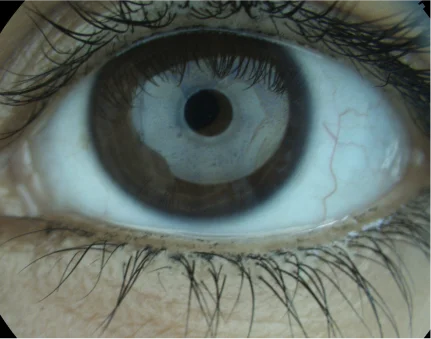Tear Meniscus Height (TMH)

Understanding Tear Meniscus Height (TMH)
What is TMH Analysis?

Tear meniscus height (TMH) analysis is a clinical method used to measure tear film volume, playing a crucial role in diagnosing and managing dry eye disease (DED). The tear meniscus forms at the edge of the eyelid and serves as a key indicator of ocular surface health. TMH is widely considered a reliable measure for evaluating tear production and tear film stability. A lower TMH often indicates insufficient tear production, which is a hallmark of dry eye conditions.
Challenges in TMH Analysis
While TMH analysis is a valuable tool for assessing dry eye disease, practical challenges remain in its routine clinical application. With a rising prevalence worldwide, DED presents significant socio-economic concerns and affects patients' quality of life.
Performing TMH analysis typically requires specialized instruments such as slit-lamps, corneal topographers, or optical coherence tomography (OCT). Although slit lamps are more accessible, they often lack the ability to precisely quantify TMH, making objective measurement difficult. Additionally, the availability of advanced diagnostic tools may be limited in resource-constrained environments, further hindering comprehensive dry eye assessments.
Challenges in TMH Analysis
While TMH analysis is a valuable tool for assessing dry eye disease, practical challenges remain in its routine clinical application. With a rising prevalence worldwide, DED presents significant socio-economic concerns and affects patients' quality of life.
Performing TMH analysis typically requires specialized instruments such as slit-lamps, corneal topographers, or optical coherence tomography (OCT). Although slit lamps are more accessible, they often lack the ability to precisely quantify TMH, making objective measurement difficult. Additionally, the availability of advanced diagnostic tools may be limited in resource-constrained environments, further hindering comprehensive dry eye assessments.
FH-POISE for TMH Analysis
FH-POISE provides integrated insights for TMH analysis by processing magnified images of the lower eyelid captured non-invasively using our ophthalmic cameras.
How FH-POISE Supports TMH Analysis
Insight-Based Measurement
It detects and quantifies TMH with high precision from captured images.
Objective Reporting
Provides clear, quantitative data on tear meniscus height to guide clinical decisions.
Enhanced Accessibility
Enables TMH assessment without the need for dedicated, high-cost instruments.
Consistent Monitoring
Supports longitudinal tracking of tear film changes for better management of dry eye disease.
By integrating advanced AI with accessible imaging technology, FH-POISE enables clinicians to conduct accurate TMH assessments, facilitating early diagnosis and improved patient care for dry eye disease.
References and External Links
- Clinical Significance of Tear Menisci in Dry Eye
https://journals.lww.com/claojournal/abstract/2012/05000/clinical_significance_of_tear_menisci_in_dry_eye.9.aspx - TFOS DEWS II Diagnostic Methodology report
https://www.sciencedirect.com/science/article/pii/S1542012417301106?pes=vor&utm_source=tfo&getft_integrator=tfo - Dry Eye Syndrome
https://eyewiki.org/Dry_Eye_Syndrome - Evaluation of tear meniscus height using different clinical methods
https://pubmed.ncbi.nlm.nih.gov/33689662/ - The Environmental Sustainability of Dry Eye Disease
https://eyewiki.org/The_Environmental_Sustainability_of_Dry_Eye_Disease#cite_note-:10-10 - The global prevalence of dry eye disease: A Bayesian view
https://pubmed.ncbi.nlm.nih.gov/34545606/ - Prevalence and risk factors of dry eye disease in North India: Ocular surface disease index-based cross-sectional hospital study
https://pmc.ncbi.nlm.nih.gov/articles/PMC5819096/ - The economic burden of dry eye disease in the United States: a decision tree analysis
https://pubmed.ncbi.nlm.nih.gov/21045640/ - Economic burden and loss of quality of life from dry eye disease in Canada
https://pmc.ncbi.nlm.nih.gov/articles/PMC8444260/ - The Association of Dry Eye Symptoms with Socioeconomic Factors and quality of Life
https://www.clinsurggroup.us/Clinical-Research-Ophthalmology/JCRO-1-102.php - Identifying Key Socioeconomic Burdens Associated with Dry Eye Disease
https://www.ajmc.com/view/identifying-key-socioeconomic-burdens-associated-with-dry-eye-disease - Prevalence of dry eye disease symptoms, associated factors and impact on quality of life among medical students during the pandemic
https://www.nature.com/articles/s41598-024-75345-w - Tear meniscus height agreement and reproducibility between two corneal topographers and spectral-domain optical coherence tomography
https://www.tandfonline.com/doi/full/10.1080/08164622.2024.2341833#abstract






